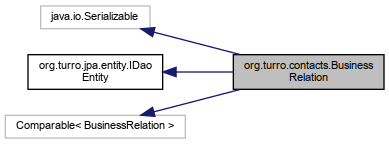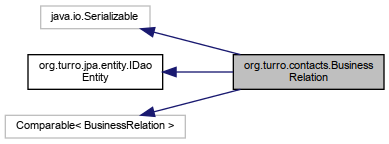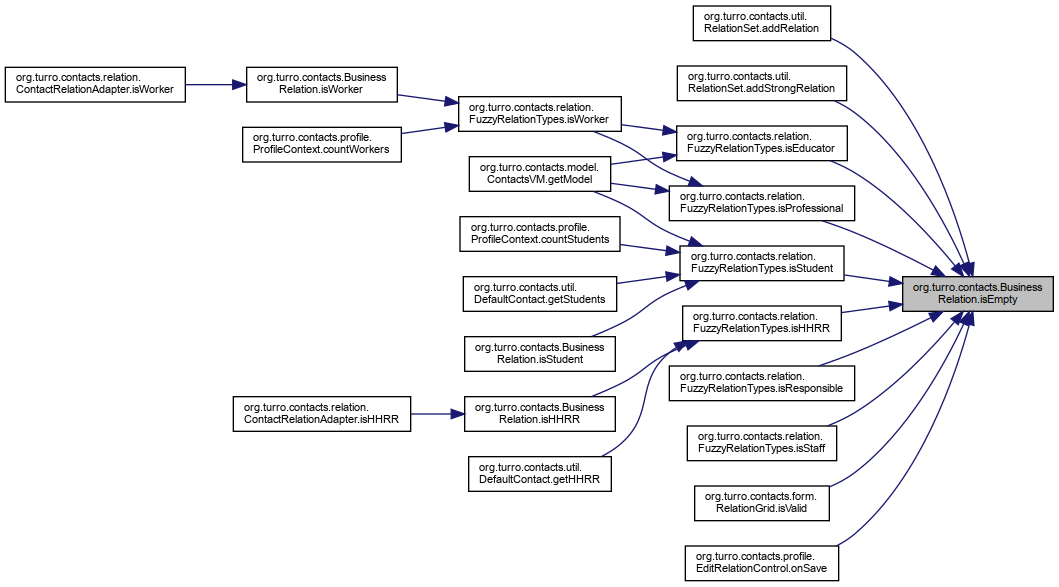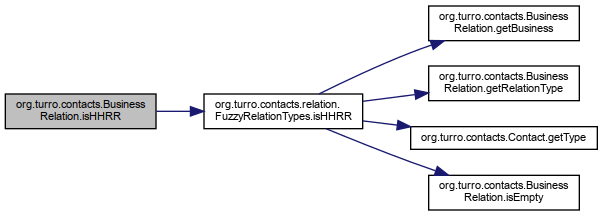◆ compareTo()
Definition at line 230 of file BusinessRelation.java.
231 int result = CompareUtil.compare(validated, o.validated);
233 result = CompareUtil.compare(preferential, o.preferential);
236 result = CompareUtil.compare(endDate, o.endDate);
239 result = CompareUtil.compare(startDate, o.startDate);
242 result = CompareUtil.compare(description, o.description);
245 result = CompareUtil.compare(
id, o.id);
◆ entityId()
| Object org.turro.contacts.BusinessRelation.entityId |
( |
| ) |
|
◆ getBusiness()
| Contact org.turro.contacts.BusinessRelation.getBusiness |
( |
| ) |
|
◆ getContact()
| Contact org.turro.contacts.BusinessRelation.getContact |
( |
| ) |
|
◆ getDatesString()
| String org.turro.contacts.BusinessRelation.getDatesString |
( |
| ) |
|
◆ getDescription()
| String org.turro.contacts.BusinessRelation.getDescription |
( |
| ) |
|
◆ getEndDate()
| Date org.turro.contacts.BusinessRelation.getEndDate |
( |
| ) |
|
◆ getFormattedDescription()
| String org.turro.contacts.BusinessRelation.getFormattedDescription |
( |
| ) |
|
Definition at line 185 of file BusinessRelation.java.
186 PhraseBuilder pb =
new PhraseBuilder();
187 if(!Strings.isBlank(relationType)) {
188 pb.addWord(I_.byKey(relationType.substring(1)));
190 pb.addWord(description);
192 return pb.toString();
◆ getId()
| String org.turro.contacts.BusinessRelation.getId |
( |
| ) |
|
◆ getImage()
| String org.turro.contacts.BusinessRelation.getImage |
( |
| ) |
|
Definition at line 202 of file BusinessRelation.java.
203 if(!Strings.isBlank(relationType)) {
204 if(relationType.startsWith(
"$INT")) {
205 return Images.getImage(
"contract");
207 RelationType rt = RelationType.getFromString(relationType);
209 return rt.getImage();
◆ getRelated()
| String org.turro.contacts.BusinessRelation.getRelated |
( |
| ) |
|
◆ getRelationType()
| String org.turro.contacts.BusinessRelation.getRelationType |
( |
| ) |
|
◆ getStartDate()
| Date org.turro.contacts.BusinessRelation.getStartDate |
( |
| ) |
|
◆ getStatus()
◆ getType()
| RelationType org.turro.contacts.BusinessRelation.getType |
( |
| ) |
|
◆ isEmpty()
| boolean org.turro.contacts.BusinessRelation.isEmpty |
( |
| ) |
|
◆ isHHRR()
| boolean org.turro.contacts.BusinessRelation.isHHRR |
( |
| ) |
|
◆ isPreferential()
| boolean org.turro.contacts.BusinessRelation.isPreferential |
( |
| ) |
|
◆ isResponsible()
| boolean org.turro.contacts.BusinessRelation.isResponsible |
( |
| ) |
|
◆ isStudent()
| boolean org.turro.contacts.BusinessRelation.isStudent |
( |
| ) |
|
◆ isTyped()
| boolean org.turro.contacts.BusinessRelation.isTyped |
( |
| ) |
|
Definition at line 159 of file BusinessRelation.java.
160 return !Strings.isBlank(relationType) && relationType.startsWith(
"$");
◆ isValidated()
| boolean org.turro.contacts.BusinessRelation.isValidated |
( |
| ) |
|
◆ isWorker()
| boolean org.turro.contacts.BusinessRelation.isWorker |
( |
| ) |
|
◆ setBusiness()
| void org.turro.contacts.BusinessRelation.setBusiness |
( |
Contact |
business | ) |
|
◆ setContact()
| void org.turro.contacts.BusinessRelation.setContact |
( |
Contact |
contact | ) |
|
◆ setDescription()
| void org.turro.contacts.BusinessRelation.setDescription |
( |
String |
description | ) |
|
◆ setEndDate()
| void org.turro.contacts.BusinessRelation.setEndDate |
( |
Date |
endDate | ) |
|
◆ setId()
| void org.turro.contacts.BusinessRelation.setId |
( |
String |
id | ) |
|
◆ setPreferential()
| void org.turro.contacts.BusinessRelation.setPreferential |
( |
boolean |
preferential | ) |
|
◆ setRelated()
| void org.turro.contacts.BusinessRelation.setRelated |
( |
String |
related | ) |
|
◆ setRelationType()
| void org.turro.contacts.BusinessRelation.setRelationType |
( |
String |
relationType | ) |
|
◆ setStartDate()
| void org.turro.contacts.BusinessRelation.setStartDate |
( |
Date |
startDate | ) |
|
◆ setValidated()
| void org.turro.contacts.BusinessRelation.setValidated |
( |
boolean |
validated | ) |
|
The documentation for this class was generated from the following file:


 Public Member Functions inherited from org.turro.jpa.entity.IDaoEntity
Public Member Functions inherited from org.turro.jpa.entity.IDaoEntity











